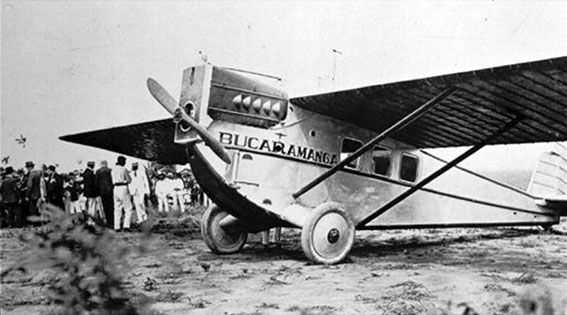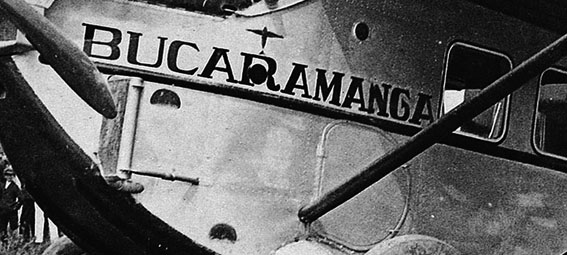|
Comets in Colombia's sky
© Lennart Andersson 2016 |
 |
The relative isolation of the Santander Department in north-eastern Colombia prompted a group of citizens in the city of Bucaramanga to found the Compañia Santandereana de Aviación (Cosada) on 12 March 1923 to explore the possibility of an air service in the region. Contact was made with Scadta, Colombia's major airline company, for help with ordering aircraft. The four-passenger Dornier Do P Komet was chosen and Fritz Hammer, Scadta's representative in Berlin, placed an order with the factory in Friedrichshafen on Cosada's behalf.
Cosada's Komet (c/n 45) was shipped from Germany in October 1923. Scadta's chief pilot Helmuth von Krohn and Werner Junck, a Scadta pilot since January 1923, were at Barranquilla in the north of Colombia to supervise assembly and testing of the new aircraft. A few weeks before the arrival of the Komet von Krohn had been flying aerobatics over Barranquilla with a Fokker named "Libertador", performing loopings and spins to the amazement of a large number of onlookers. Two Fokker C.IIs had been imported for an airmail service between the cities Medellin, Manizales and Cali. The Komet was intended for an airmail and passenger service between Bucaramanga and Puerto Wilches on the Magdalena River. At this point there were connections with a passenger boat service and with Scadta.
|
 |
The Komet was first modified in Scadta's workshops and adapted for tropical conditions. An oversize frontal radiator replaced the normal unit and in addition, small extra radiators were fitted on each side of the nose. The engine cover seems to have been modified as well. The aircraft was then loaded on a boat named "Pinchincha" and sent from Barranquilla to Puerto Wilches, where it arrived late in February 1924. After assembly, Junck finally flew it to Bucaramanga, on, or about 11 March. The press reported that the trip took 60 minutes - the fastest journey ever made between the two cities in history.
For the time being the Komet was not flown because necessary paperwork had not been accomplished, but towards the end of the month it received Colombian registration A-17. On 23 March everything was ready and the citizens of Bucaramanga were invited to the official inauguration of the air service and the aircraft, which was baptised "Bucaramanga" on this occasion. It took off, first with Junck at the controls, for pleasure flights with some of the dignitaries. Von Krohn, who had arrived from Santa Maria on a Junkers F 13 floatplane, made the next flight. When he landed, the propeller and one of the wheels were damaged, and this put an end to further flying for the time being.
|
 |
| Cosada's Dornier komet was registered A-17 in Colombia. Photo: Omar Hazbon/SCADTA, a closed group on Facebook. |
The press was told that this Komet had an engine with an output of only 145hp and that it would be used only for occasional flights. In May or June a second Komet with a 220hp engine was expected to arrive. As far as known no Komet had an engine rated at 145hp and it is most probable that it was in fact powered by the 185hp BMW IIIa. The type of engine fitted in the improved Komet was the 260hp Rolls-Royce Falcon III.
The repair of the "Bucaramanga" was delayed, because spare parts had to be fetched from Puerto Wilches. Only in mid-April did von Krohn, who was now Cosada's technical director, arrive with the necessary parts. The problem was that "Bucaramanga" had been found to be unsuited for operations under the given geographical and climatic conditions. It could barely get off the ground with a reasonable load.
On 12 June Junck made a taxi flight to Puerto Wilches with a full load of passengers, but by then Cosada's fate was almost sealed. Its only aircraft had been found to be unsuitable for its purpose and on 8 June Helmuth von Krohn died in an accident with Scadta's Junkers F 13 "Tolima".
|
 |
| Photo: Omar Hazbon/SCADTA, a closed group on Facebook. |
So what was actually the final fate of Cosada's Komet aircraft? Was only one example delivered, or were there two? Published works on Colombian aviation history mention just one, but there is evidence that a second aircraft was delivered. The first, c/n 45, must have been the one mentioned above. It reappeared in Germany in 1926, when it was sold to Deutsche Luft Hansa with a new and more powerful engine and the registration D943. This is consistent with the fact that "Cosada's Komet" was disassembled after lying unused for a year or so, packed and returned to Germany.
Things are complicated by the fact that a second Komet, c/n 49, was sold to Fritz Hammer and delivered to Colombia, reportedly in February 1924. This aircraft was powered by the 260hp Rolls-Royce Falcon. Nothing is known about its fate and it seems to have vanished from the scene without a trace. Was the flight with "a full load" of passengers made by Junck in June 1924 in fact made with this aircraft, and not the first Komet? None of the two aircraft had a subsequent history in Colombia and only one of them seem to have been returned to Germany. So what happened with the missing example?
In 1925-1926 Scadta transferred Junkers F 13 A-18 "Huila", which was renamed "Cúcuta", and A-21"Bucaramanga" to Cosada and the airline finally started operations with this these aircraft, which were apparently better suited to local conditions in Santander, than the Dornier Komet.
|
|
|
|





